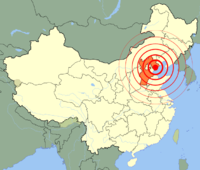
Photo from wikipedia
Abstract Dechlorane Plus (DP) is a highly chlorinated flame retardant that exists widely in the environment. In the present study, we studied the distribution, potential sources and inventory of DP… Click to show full abstract
Abstract Dechlorane Plus (DP) is a highly chlorinated flame retardant that exists widely in the environment. In the present study, we studied the distribution, potential sources and inventory of DP in surface sediment samples from Bohai Sea (BS) and the northern part of the Yellow Sea (NPYS), China. The concentrations of DP in surface sediments ranged from 19.90 to 118.5 pg/g dry weight (dw), with a mean value of 57.30 pg/g dw (excluding K3 station), which are in general lower than most of the previously reported values in other regions. The highest DP concentration appeared at K3 station near the city of Dalian, and the next high concentration occurred in the mud area of the eastern Bohai Bay. We used an integrated approach, in which the traditional fractional abundance of anti-DP ( f anti ) was combined with terrestrial biomarker lignin, to identify sources of DP in the region. We found that DP in the estuarine area was mainly from the Yellow River input. Similarly, Yalu River input was the major contributor of DP in NPYS. On the other hand, DP in the mud area of the eastern Bohai Bay was mainly from atmospheric deposition and the hydrodynamic transport. The sedimentary burden of DP for the surface sediment of a thickness of 3 cm in BS and NPYS was estimated to be 254.4 kg, with a spatial density of 17.20 pg/cm2.
Journal Title: Regional Studies in Marine Science
Year Published: 2020
Link to full text (if available)
Share on Social Media: Sign Up to like & get
recommendations!